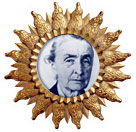
 Georgia O'Keeffe was a pioneer,
in her role as a prominent and determined American woman artist
and in her decision to live and paint in the Southwest. O'Keeffe
was the first woman to have a retrospective at the Museum of Modern
Art in New York in 1945. She began spending her summers in New Mexico
in 1929 and moved permanently to Abiquiu in 1949. From this time
until her death at the age of 99 in 1986, she was inspired by the
landscape and people of her new home. Horse's Skull on Blue is the
first of a series of paintings of skulls which O'Keeffe painted
from bones she found in the desert around her ranch.
Georgia O'Keeffe was a pioneer,
in her role as a prominent and determined American woman artist
and in her decision to live and paint in the Southwest. O'Keeffe
was the first woman to have a retrospective at the Museum of Modern
Art in New York in 1945. She began spending her summers in New Mexico
in 1929 and moved permanently to Abiquiu in 1949. From this time
until her death at the age of 99 in 1986, she was inspired by the
landscape and people of her new home. Horse's Skull on Blue is the
first of a series of paintings of skulls which O'Keeffe painted
from bones she found in the desert around her ranch.
O'Keeffe was originally from Wisconsin and she studied art at the Art Student's League in New York City for a year. As a young woman in 1916, she went to the rural area of Canyon, Texas for a year to teach art at a small school. While there, a friend in New York showed O'Keeffe's abstract watercolors of the West Texas landscape to the gallery owner and photographer Alfred Steiglitz. Steiglitz championed the emerging American modernist artists - such as Arthur Dove, Marsden Hartley and John Marin - supporting them financially and showing their work at his gallery called "291", named for it's address on Fifth Avenue. Steiglitz's gallery was the first venue in the country to actively exhibit avant-garde American and European art, including artists such as Picasso, Matisse and Duchamp. Steiglitz exhibited O'Keeffe's West Texas watercolors in 1917, which was his last gallery exhibition, and the two became lovers and married in 1924.
Before moving to the Southwest, O'Keeffe painted a series of New York cityscapes and flowers. O'Keeffe started painting close, cropped examinations of the colors and shapes of the flowers at Steiglitz's country home in upstate New York. O'Keeffe applied this same scrutiny to Horse's Skull on Blue. The blue background of the painting refers to the clear, blue skies that dominate the landscape of New Mexico. The artist's choice to paint a sun-bleached skull is due in large part to her environment. But the painting is also part of the memento mori tradition of still life paintings, which refer to the fleeting nature of life by including symbols of death such as skulls or perishable foods and plants. Take a look at the still lifes by Willem Kalf and Peale in the American Gallery for another look at memento mori.
![]()